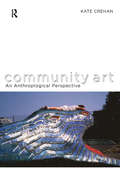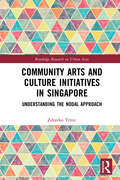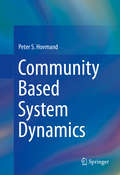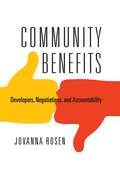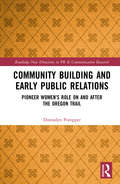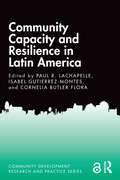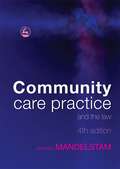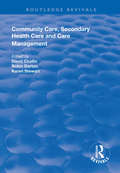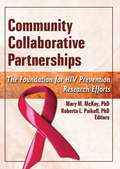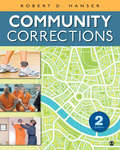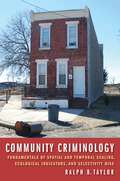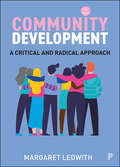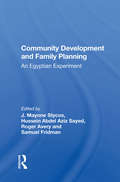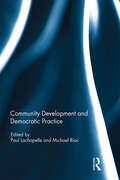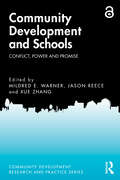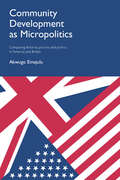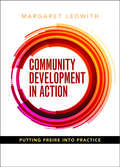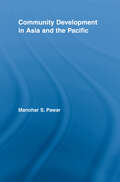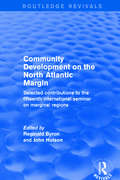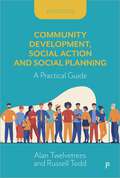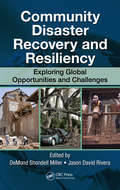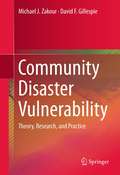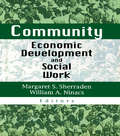- Table View
- List View
Community Art: An Anthropological Perspective
by Kate CrehanExploring key issues for the anthropology of art and art theory, this fascinating text provides the first in-depth study of community art from an anthropological perspective.The book focuses on the forty year history of Free Form Arts Trust, an arts group that played a major part in the 1970s struggle to carve out a space for community arts in Britain. Turning their back on the world of gallery art, the fine-artist founders of Free Form were determined to use their visual expertise to connect, through collaborative art projects, with the working-class people excluded by the established art world. In seeking to give the residents of poor communities a greater role in shaping their built environment, the artists' aesthetic practice would be transformed.Community Art examines this process of aesthetic transformation and its rejection of the individualized practice of the gallery artist. The Free Form story calls into question common understandings of the categories of "art," "expertise," and "community," and makes this story relevant beyond late twentieth-century and early twenty-first-century Britain.
Community Arts and Culture Initiatives in Singapore: Understanding the Nodal Approach (Routledge Research on Urban Asia)
by Zdravko TrivicWhat Can Space Do for the Arts?; What Can Arts Do for Space?; and What Can Arts and Space Do for the Community? Through the lenses of creative placemaking and neighbourhood arts ecology, Trivic re-examines the position of community arts in the spatial, social and cultural landscape. Emphasising urban design considerations of complex interdependent relationships between arts, space and people, he re-explores the role of community-based arts activities in shaping urban neighbourhoods, enriching public life and empowering communities. This is divided into an analysis of spatial opportunities for the arts in the neighbourhood; and a study of the impacts of bringing arts and culture activities into local neighbourhoods and communities, using Singapore’s nodal approach as a developed case study. Using spatial opportunity analysis, the book demonstrates a step-by-step procedure for identification and evaluation of the neighbourhood spaces that work best for community arts and culture activities. In the study of impacts, Trivic proposes a holistic framework for capturing and evaluating the non-economic impacts of arts and culture, on space, society, well-being, education and participation. An invaluable template for arts event organisers and artists to assess and maximise the outcomes of their creative efforts in local neighbourhoods, as well as an important reading for students and practitioners of neighbourhood planning, urban design, and creative placemaking.
Community Based System Dynamics
by Peter S. HovmandCommunity Based System Dynamics introduces researchers and practitioners to the design and application of participatory systems modeling with diverse communities. The book bridges community- based participatory research methods and rigorous computational modeling approaches to understanding communities as complex systems. It emphasizes the importance of community involvement both to understand the underlying system and to aid in implementation. Comprehensive in its scope, the volume includes topics that span the entire process of participatory systems modeling, from the initial engagement and conceptualization of community issues to model building, analysis, and project evaluation. Community Based System Dynamics is a highly valuable resource for anyone interested in helping to advance social justice using system dynamics, community involvement, and group model building, and helping to make communities a better place.
Community Benefits: Developers, Negotiations, and Accountability (The City in the Twenty-First Century)
by Jovanna RosenIn Community Benefits, Jovanna P. Rosen explores a new pattern in urban development: local residents and community representatives leveraging large-scale development projects for agreements that promise dedicated local benefits, such as parks and jobs. In general, such development projects have not produced impactful benefits for local residents, and often have contributed to significant community harm, including gentrification and displacement. In response, community activists have launched a fight to control development, using benefits-sharing agreements to ensure that projects produced better outcomes for local residents. While such agreements now exist across the nation, the process of negotiating and enforcing them remains challenging. This book dives deep into four case studies—in Los Angeles, Atlanta, Seattle, and Milwaukee—to answer the following questions: Who ultimately benefits from both the agreements and the projects in question? How do benefits get delivered, and who controls this process? What works for these agreements to successfully produce community outcomes?Rosen shows that, without agreements that promote accountability, developers and other project proponents can walk away from the negotiating table once the agreement is signed and the development moves forward. This disregard for community benefits and priorities can leave community residents solely responsible for benefits delivery during implementation, but with few viable avenues to ensure that outcomes materialize. The cases reveal specific elements that agreements require to achieve success during implementation: community participation, managerial connections, effective partnerships, responsiveness, and vigorous oversight with accountability mechanisms. Although creating these conditions is difficult, sometimes impossible, and contingent on fragile processes, Rosen concludes the book with recommendations for both the agreement negotiation and implementation phases to ensure success.
Community Building and Early Public Relations: Pioneer Women’s Role on and after the Oregon Trail (Routledge New Directions in PR & Communication Research)
by Donnalyn PompperFrom the start, women were central to a century of westward migration in the U.S. Community Building and Early Public Relations: Pioneer Women’s Role on and after the Oregon Trail offers a path forward in broadening PR's Caucasian/White male-gendered history in the U.S. Undergirded by humanist, communitarian, critical race theory, social constructionist perspectives, and a feminist communicology lens, this book analyzes U.S. pioneer women's lived experiences, drawing parallels with PR's most basic functions – relationship-building, networking, community building, boundary spanning, and advocacy. Using narrative analysis of diaries and reminiscences of women who travelled 2,000+ miles on the Oregon Trail in the mid-to-late 1800s, Pompper uncovers how these women filled roles of Caretaker/Advocate, Community Builder of Meeting Houses and Schools, served a Civilizing Function, offered Agency and Leadership, and provided Emotional Connection for Social Cohesion. Revealed also is an inevitable paradox as Caucasian/White pioneer women’s interactional qualities made them complicit as colonizers, forever altering indigenous peoples’ way of life. This book will be of interest to undergraduate and graduate PR students, PR practitioners, and researchers of PR history and social identity intersectionalities. It encourages us to expand the definition of PR to include community building, and to revise linear timeline and evolutionary models to accommodate voices of women and people of color prior to the twentieth century.
Community Capacity and Resilience in Latin America (Community Development Research and Practice Series)
by Cornelia Butler Flora Paul R. Lachapelle Isabel Gutierrez-MontesCommunity Capacity and Resilience in Latin America addresses the role of communities in building their capacity to increase resiliency and carry out rural development strategies in Latin America. Resiliency in a community sense is associated with an ability to address stress and respond to shock while obtaining participatory engagement in community assessment, planning and outcome. Although the political contexts for community development have changed dramatically in a number of Latin American countries in recent years, there are growing opportunities and examples of communities working together to address common problems and improve collective quality of life. This book links scholarship that highlights community development praxis using new frameworks to understand the potential for community capacity and resiliency. By rejecting old linear models of development, based on technology transfer and diffusion of technology, many communities in Latin America have built capacity of their capital assets to become more resilient and adapt positively to change. This book is an essential resource for academics and practitioners of rural development, demonstrating that there is much we can learn from the skills of self-diagnosis and building on existing assets to enhance community capitals. Chapter 3 of this book is freely available as a downloadable Open Access PDF at http://www.taylorfrancis.com under a Creative Commons Attribution (CC-BY) 4.0 license.
Community Care Practice and the Law: Fourth Edition
by Michael MandelstamThis fourth edition of Community Care Practice and the Law has been fully updated to reflect the rapid and continuing legal, policy and practice changes affecting community care. It provides comprehensive and jargon-free explanations of community care legislation, as well as other areas of law directly relevant to practitioners, including the NHS, disabled facilities grants and housing adaptations, asylum and immigration, mental capacity, human rights, disability discrimination, health and safety at work and negligence - and a range of legal provisions relevant to the protection and safeguarding of adults. Apart from the burgeoning legal case law and ombudsman investigations, changes from the last edition include coverage of the Mental Capacity Act 2005, legal implications of 'self directed care' and 'individual budgets', changes to direct payments and 'ordinary residence' determinations. In particular, new guidance applies to the high profile issue of NHS continuing health care. The book is an essential guide for practitioners and managers in both the statutory and voluntary sectors, policy makers in local authorities and the NHS, advocates, lawyers and social work students.
Community Care, Secondary Health Care and Care Management (Routledge Revivals)
by Karen Stewart David Challis Robin DartonFirst published in 1998, creating a discourse on community care, differences in of care management; links between assessment, secondary health care and care management by addressing several areas which provide opportunities for successful service development.
Community Collaborative Partnerships: The Foundation for HIV Prevention Research Efforts
by Mary M. Mckay Roberta L. PaikoffFind out how best to develop HIV prevention programs that workCommunity Collaborative Partnerships: The Foundation for HIV Prevention Research Efforts is a must read for anyone interested in developing prevention programs within high-risk urban environments. Illustrative case studies, quality research, revealing personal stories, and helpful tables and figures provide valuable insights on innovative ways to partner in the prevention of the spread of HIV in youths. Leading experts in the field offer practical strategies to dissolve the distrust individuals in a community hold for researchers not a part of that community, fostering an effective collaboration to deal with problems. The book also describes ways to go beyond the United States&’ model to reveal how to replicate the same dynamic relationships in international communities.Active participation with the community and families has been found to be vital for the success of HIV/AIDS prevention efforts. Community Collaborative Partnerships: The Foundation for HIV Prevention Research Efforts solves the common problem of forcing ineffective program models onto an unreceptive community. Program developers get the necessary tools to develop relationships and cultivate substantive input from those in the community to help ensure better program results. The research here is up-to-date, and the suggestions invaluable.Topics in Community Collaborative Partnerships: The Foundation for HIV Prevention Research Efforts include: the role of parenting in mental health and HIV risk research findings about frequency of sexual intercourse among adolescents racial socialization and family role in HIV knowledge family influences on exposure to situations of sexual possibility preadolescent risk behavior influence on parental monitoring strategies for collaboration between community and academic HIV prevention researchers involving urban parents as collaborators in HIV prevention research motivators-and barriers-to participation of minority families in a prevention program transferring a university-led HIV prevention program to the community Trinidad and Tobago HIV/AIDS prevention using a family-based program and much more!Community Collaborative Partnerships: The Foundation for HIV Prevention Research Efforts is valuable reading for researchers, program developers, community-based organizations, public policy/advocacy organizations, community organizers, educators, and students in the fields of social work, public health, public administration, and community medicine.
Community Corrections
by Robert D. HanserOffering comprehensive coverage with an applied, practical perspective, Community Corrections, Second Edition covers all the major topics in the field while emphasizing reintegration and community partnerships and focusing strongly on assessment, risk prediction, and classification. Author Robert D. Hanser draws on his expertise with offender treatment planning, special needs populations, and the comparative criminal justice fields to present a complete assessment of the issues and challenges facing community corrections today. Insights into how the day-to-day practitioner conducts business in community corrections are illustrated by such things as the increasing role technology plays in the field.
Community Corrections
by Robert D. HanserOffering comprehensive coverage with an applied, practical perspective, Community Corrections, Second Edition covers all the major topics in the field while emphasizing reintegration and community partnerships and focusing strongly on assessment, risk prediction, and classification. Author Robert D. Hanser draws on his expertise with offender treatment planning, special needs populations, and the comparative criminal justice fields to present a complete assessment of the issues and challenges facing community corrections today. Insights into how the day-to-day practitioner conducts business in community corrections are illustrated by such things as the increasing role technology plays in the field.
Community Criminology: Fundamentals of Spatial and Temporal Scaling, Ecological Indicators, and Selectivity Bias (New Perspectives in Crime, Deviance, and Law #12)
by Ralph B. TaylorFor close to a century, the field of community criminology has examined the causes and consequences of community crime and delinquency rates. Nevertheless, there is still a lot we do not know about the dynamics behind these connections. In this book, Ralph Taylor argues that obstacles to deepening our understanding of community/crime links arise in part because most scholars have overlooked four fundamental concerns: how conceptual frames depend on the geographic units and/or temporal units used; how to establish the meaning of theoretically central ecological empirical indicators; and how to think about the causes and consequences of non-random selection dynamics. The volume organizes these four conceptual challenges using a common meta-analytic framework. The framework pinpoints critical features of and gaps in current theories about communities and crime, connects these concerns to current debates in both criminology and the philosophy of social science, and sketches the types of theory testing needed in the future if we are to grow our understanding of the causes and consequences of community crime rates. Taylor explains that a common meta-theoretical frame provides a grammar for thinking critically about current theories and simultaneously allows presenting these four topics and their connections in a unified manner. The volume provides an orientation to current and past scholarship in this area by describing three distinct but related community crime sequences involving delinquents, adult offenders, and victims. These sequences highlight community justice dynamics thereby raising questions about frequently used crime indicators in this area of research. A groundbreaking work melding past scholarly practices in criminology with the field’s current needs, Community Criminology is an essential work for criminologists.
Community Custodians of Popular Music's Past: A DIY Approach to Heritage (Routledge Research in Music)
by Sarah BakerThis book examines do-it-yourself (DIY) approaches to the collection, preservation, and display of popular music heritage being undertaken by volunteers in community archives, museums and halls of fame globally. DIY institutions of popular music heritage are much more than ‘unofficial’ versions of ‘official’ institutions; rather, they invoke a complex network of affect and sociality, and are sites where interested people – often enthusiasts – are able to assemble around shared goals related to the preservation of and ownership over the material histories of popular music culture. Drawing on interviews and observations with founders, volunteers and heritage workers in 23 DIY institutions in Australasia, Europe and North America, the book highlights the potentialities of bottom-up, community-based interventions into the archiving and preservation of popular music’s material history. It reveals the kinds of collections being housed in these archives, how they are managed and maintained, and explores their relationship to mainstream heritage institutions. The study also considers the cultural labor of volunteers in the DIY institution, arguing that while these are places concerned with heritage management and the preservation of artefacts, they are also extensions of musical communities in the present in which activities around popular music preservation have personal, cultural, community and heritage benefits. By looking at volunteers’ everyday interventions in the archiving and curating of popular music’s material past, the book highlights how DIY institutions build upon national heritage strategies at the community level and have the capacity to contribute to the democratization of popular music heritage. This book will have a broad appeal to a range of scholars in the fields of popular music studies, musicology, ethnomusicology, archive studies and archival science, museum studies, critical heritage studies, cultural studies, cultural sociology and media studies.
Community Development 3e: A Critical and Radical Approach
by Margaret LedwithCommunity development’s social justice principles are under threat from the current resurgence of far-Right politics. The dangerous escalation of economic inequalities calls for new ideas on power and new approaches to practice. Rooted in radical community development’s strong theoretical foundation in Freire and Gramsci, the body of knowledge is expanded to make sense of these challenging times, introducing exciting new ideas for those working in this field. Written in an engaging style, linking theory to action using cartoons, international case studies and key concept summaries, the fully updated third edition of this bestselling book offers an inspiring approach to practice for all those committed to social and environmental justice.
Community Development And Family Planning: An Egyptian Experiment
by J. Mayone StycosProgram evaluation is not among the most popular of exercises, since it carries risks for all associated with it. Because every important program has friends and enemies anxious for its prosperity or demise, the investigators and their findings will normally be attacked from at least one side and not infrequently from both. But this is an occupational hazard, dutifully accepted by its practitioners; for some it even adds a zestful touch of danger. However, the program's sponsors and its participants require an unusual degree of courage, since negative or indifferent results are not infrequently used to impugn their wisdom or dedication. We applaud the courage of all those who, in the interest of improving policies and programs to further their clients' well-being, assumed the risks of introducing scientific program evaluation: Primary credit goes to the sponsor of the current research, the United Nations Fund for Population Activities (UNFPA), in particular the Mediterranean and Middle East Branch and its chief, Roushdi El Henedi. Special thanks go to Dr. Habib Siddiqui for his stimulus in launching the study. His efforts were followed by those of M.A. Abu-Nuwar, whose bureaucratic and diplomatic skills were much appreciated, and Sylvia Rhodes, who was of assistance near the close of the project. UNFPA staff in Egypt, in particular Hamed Fahmy, were most helpful in the field. Needless to say, neither these individuals nor the UNFPA necessarily agree with the conclusions reached in this book.
Community Development and Democratic Practice (Community Development – Current Issues Series)
by Michael Rios Paul LachapelleThis book is the outcome of a multiyear process of participatory meetings, individual and collective writings, and insightful criticisms sponsored by the Kettering Foundation regarding the intersection of community development and democratic practice. The collective outcome from these processes is a wide range of innovative articles at the forefront of thinking about the intersections of power, participation, and engagement in the realm of community practice. The authors highlight a range of case studies that vary by location, scale, and purpose. The book serves as a heuristic framework for ‘democratic community development’ and raises several related questions about how democracy, community, and the public are constituted, and what processes, end goals, methods, and tools are to be used to further democratic community development. This book was originally published as a special issue of the journal Community Development.
Community Development and Schools: Conflict, Power and Promise (ISSN)
by Mildred E. Warner Xue Zhang Jason ReeceThis book lays out the promise and potential of schools as community-building institutions. It explores the challenges faced in incorporating schools into broader community development policy, and also recognizes the changing demographics of schools and their need to integrate with economic development policy in order to promote broader community development.The book includes chapters on tax abatements and economic development policy impacts on schools, new approaches to school building renovation, the potential and reach of shared services between communities and schools, and the impact of school-based health centers. It also offers a theory to integrate schools into community development. Key elements include shared power between communities and schools, greater transparency in economic development policy, collaboration across the broad range of community actors, and engagement of diverse voices. These elements build a greater sense of belonging across generations and class and racial divides.Creative democracy can broaden both school and community development agendas and build a culture of health. This book will help community development and school leaders recognize and pursue the promise of schools as critical community development actors.The Open Access version of this book, available at http://www.taylorfrancis.com, has been made available under a Creative Commons Attribution-Non Commercial (CC-BY-NC) 4.0 license.
Community Development as Micropolitics: Comparing Theories, Policies and Politics in America and Britain
by Akwugo EmejuluCommunity development is routinely invoked as a practical solution to tackle a myriad of social problems, even though there is little consensus about its meaning and purpose. Through a comparative analysis of competing perspectives on community development since 1968, this book critically examines the contradictory ideas and practices that have shaped this field in the US and the UK. This approach exposes a problematic politics that have far-reaching consequences for those committed to working for social justice. This accessible book offers an alternative model for thinking about the politics of community development and so will appeal to academics, postgraduate students and community development workers.
Community Development in Action: Putting Freire into Practice
by Margaret LedwithIn a world in which social divisions are widening not lessening, it is essential for community development, or any other practice committed to social justice and sustainability, to understand how power works at every level, from grassroots projects to movements for change. This exciting and practical book is filled to the brim with useful ideas for busy practitioners. Building on the work of Paulo Freire, theories are presented in interesting and straightforward ways to provide an everyday reference for practice. Contained in these pages is all you need to give your practice a critical edge!
Community Development in Asia and the Pacific (Routledge Studies in Development and Society)
by Manohar S. PawarThere is a tremendous need for community development practice in the Asia-Pacific region due to its size and prevailing diverse socio-economic, political and cultural needs and issues. Both developed and developing countries have been reemphasizing the importance of community development and have introduced several schemes or programs for overall development. Manohar Pawar familiarizes readers with the region, presents the major social, economic and political issues, looks at values and principles, and critically analyses challenges and shows opportunities for community development practice in the region. This book will allow for anyone interested in community development both at local and global levels – scholars, non-government organizations (NGOs), government organisations, international aid agencies – to gain a broad understating of community development trends in the Asia-Pacific region.
Community Development on the North Atlantic Margin: Selected Contributions to the Fifteenth International Seminar on Marginal Regions (Routledge Revivals)
by John Hutson Reginald ByronThis title was first published in 2001. Isolated communities, dependent upon fishing, farming and forestry, which are scattered around the North Atlantic coast, have shared a disastrous decline during the last decade. These communities are in the peripheries of advanced industrial nation-states, such as Canada and supra-national alliances, such as the European Community, yet despite this, there are no easy solutions to the development of these regions. This volume argues that the productive assets of these regions, and how they can be used to sustain household incomes, need to be better understood. The assets need to be converted into products and services and they need to be marketed profitably. The diminshing flow of young people who leave these areas to obtain higher education and who do not return must be turned around and efforts must be concentrated on the creation or strengthening of economic conditions which satisfy the younger generation's employment aspirations, consumer requirements and social needs.
Community Development, Social Action and Social Planning 6e: A Practical Guide
by Alan Twelvetrees Russell ToddThe sixth, fully updated edition of this bestselling guide links the theory and practice of community work in an insightful and relatable read for students and practitioners alike. With an accessible style, experienced author Alan Twelvetrees sets out the realities of practice in everyday community development (CD) work. With a much-expanded section on specialist community work, the guide also features brand new sections on work in health, housing, with children, young people and those with disabilities and the changing role of IT, particularly since the COVID-19 pandemic. This edition features: • clear ‘how to’ guides for a variety of CD-related practice; • case studies; • end of chapter discussion points; • signposts to digital resources; • glossary. This classic text provides a comprehensive overview of the knowledge required to work in community practice in the UK and is essential for anyone studying or working in the field.
Community Disaster Recovery and Resiliency: Exploring Global Opportunities and Challenges
by Jason David Rivera DeMond Shondell MillerOnce again nature‘s fury has taken a toll in pain, suffering, and lives lost. In recognition of the need for a rapid and appropriate response, CRC Press will donate $5 to the American Red Cross for every copy of Community Disaster Recovery and Resiliency: Exploring Global Opportunities and Challenges sold. In the past, societies would learn from di
Community Disaster Vulnerability: Theory, Research, and Practice
by David F. Gillespie Michael J. ZakourDisaster vulnerability is rapidly increasing on a global scale, particularly for those populations which are the historical clients of the social work profession. These populations include the very young and very old, the poor, ethnic and racial minorities, and those with physical or mental disabilities. Social workers are increasingly providing services in disasters during response and recovery periods, and are using community interventions to reduce disaster vulnerability. There is a need for a cogent theory of vulnerability and research that addresses improved community disaster practice and community resilience. Community Disaster Vulnerability and Resilience provides a unifying theoretical framework backed by research which can be translated into knowledge for effective practice in disasters.
Community Economic Development and Social Work
by Margaret S SherradenIn Community Economic Development and Social Work, you’ll find innovative theoretical approaches to the newly emerging field of community economic development (CED). You’ll see how community leaders, residents, community organizations, social workers, city planners, local business owners, bankers, and/or investors can come together to promote successful CED.Community economic development (CED) is a strategy that addresses social and economic development goals, creates jobs, builds assets, and strengthens the social fabric of communities. In Community Economic Development and Social Work, you&’ll learn how to promote community-based organizations that involve residents in articulating goals, policies, and operations and moves them beyond poverty. You’ll also gain valuable insight into: methods of evaluating a variety of CED initiatives in different geographical areas microenterprise development and the experiences of low-income entrepreneurs, including examples from Bangladesh and India and in immigrant and low-income communities in the United States home ownership as a key CED strategy in low-income neighborhoods environmental issues and sustainable CED healthcare and CED--entrepreneurial opportunities and job creation organizations, such as Community Development Corporations, that promote CED practicing CED in marginalized communities strategies for creating jobs, developing structures for savings and investment, creating access to credit, promoting land trusts, financing community infrastructure improvements, providing training and technical assistance, and developing social services Contributors to this groundbreaking volume include internationally known scholars and practitioners who examine community economic development initiatives from a variety of perspectives and locales--CED is one of the few areas of applied social science where diffusion regularly occurs from “less developed” to “developed” countries. The variety of models and case studies in Community Economic Development and Social Work gives you practical ideas for effective economic development--development that empowers residents to break the cycle of poverty and offers hope and opportunity for the future--in low-income and minority communities.
